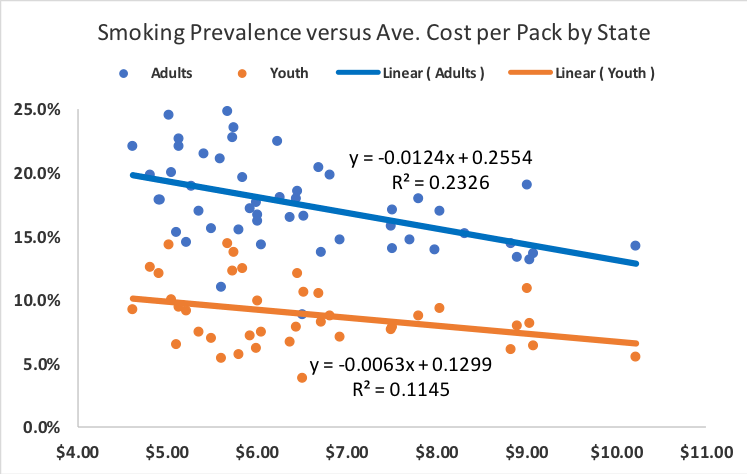On February 21, 2019, KT&G reported fourth quarter and full-year operating results for 2018. The data show that domestic cigarette industry volume is decreasing significantly – approximately 9% in 2018 and more than 14% over the last two years. What is happening?
KT&G, British American Tobacco, and Philip Morris International introduced heated tobacco products in South Korea in 2017. As witnessed in Japan, heated tobacco product sales are driving substantial annual percentage declines in South Korea domestic cigarette volume (Chart 1). Quarterly shipment volumes are volatile, but the trend is clear.

Source: Chart is based on data from company reports. KT&G reports quarterly domestic cigarette total market volume. Japan Tobacco Inc. reports monthly domestic cigarette sales volume and market share.
We believe the volume data for South Korea demonstrate primarily a substitutive effect, as is the case in Japan. The combustible cigarette stick volume decreases are for the most part offset by heated tobacco stick volume increases. The South Korea Ministry of Economy and Finance reported that heated tobacco share of tobacco sold (including cigarettes and heated tobacco) increased from 2.2% in 2017 to 9.6% in 2018. Heated tobacco products were first launched in the country in May 2017. Based on the KT&G and government reports referenced above, total stick sales volumes (cigarettes and heated tobacco) were approximately 76B in 2016, 73B in 2017, and 72B in 2018. For full-year 2018, total stick volume declined by about 2% compared to 2017 and by more than 5% relative to 2016.
After demonstrating double-digit percentage declines in South Korean domestic cigarette volume since the fourth quarter of 2017, the rate of deceleration slowed to just 1.3% during the fourth quarter of 2018. What happened?
First, South Korea’s Ministry of Food and Drug Safety announced last June that the results of its study on the safety of heated tobacco products found the products to be equally, if not more, harmful than traditional cigarettes. Second, the government decided to require the inclusion of graphic health warnings on heated tobacco product packaging effective December 23, 2018. As a result, it appears that heated tobacco product trade inventory movements were negatively impacted in the fourth quarter ahead of the change in health warnings in December 2018.
What are the stakes associated with flawed regulatory action? In South Korea, the current cigarette smoking rateamong people aged ≥15 years, based on 2016 estimates, was approximately 21.5% overall – 37.9% for men and 5.6% for women. Every year, more than 46,700 South Koreans are killed by tobacco-caused disease. Tobacco use is the number one risk factor driving both death and disability in the country.
Despite the claims by South Korea’s Ministry of Food and Drug Safety, available research shows that heated tobacco products are less harmful than smoking. Independent studies have verified findings from manufacturer reports demonstrating that hazardous compounds present in the mainstream smoke emitted by heated tobacco products are at concentrations that are much lower than those in conventional combustible cigarettes. Unfortunately, damage is done when a widely published government-supported study misleads smokers to believe they may be better off smoking combustible cigarettes than switching to alternative non-combustible tobacco products. For its part, Philip Morris International filed a lawsuit last October against the South Korean government, demanding the disclosure of test results. In addition, Philip Morris International R&D responded that the South Korean test results (1) confirm significant reductions of harmful and potentially harmful constituents (HPHCs) in heated tobacco products compared to cigarettes – but omit to discuss them, and (2) use “Tar” to compare products – a value that gives no indications on the content of HPHCs. As agreed by the WHO Study Groupon Tobacco Product Regulation, “Tar need not be measured, as it is not a sound basis for regulation, and the levels can be misleading.”
That said, and despite the fourth quarter slow-down in the rate of deceleration, the South Korean domestic cigarette industry volume decrease of more than 14% over the last two years is substantial – on an absolute basis and relative to what could be expected through traditional tobacco control measures. The Foundation believes that innovation and consumer-driven demand are part of the solution, in addition to sound policy prescriptions. The record shows that implementation of policy strategies alone is not achieving the degree and speed in the reduction of the prevalence of cigarette smoking that is witnessed in Japan and South Korea. On the other hand, the risk that faulty regulation promulgates cigarette smoking and results in premature death and disease may indeed be occurring in South Korea – at least for the time being. The Foundation believes that now is the time to bring all forces together to achieve a smoke-free world.
© 2023 Foundation for a Smoke-Free World. All rights reserved.